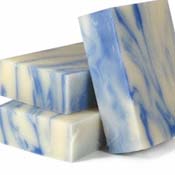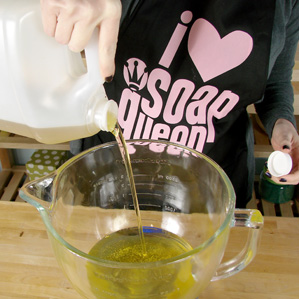Even after you’re comfortable with a particular cold-process or hot-process soap recipe, it’s still good to keep up with the resources. For instance, the tutorial on tie-dyed soap using six different colors of soap dyes that I skipped over for the longest time because it was simply above my level of expertise? Last night I read it all the way through, going “Hmmmm…..”. I sense a new technique coming my way!
Below are my favorite books, sites, and forums on soapmaking, and my go-to lye calculator. If you’re a soapmaker, then pretty please add your own favorites in the Comments section to this post. If you’re not yet a soapmaker, then I just dare you to read any of these resources and NOT immediately run to your kitchen and start mixing up a batch of soap.
Good books are essential to good soapmaking. The Soapmaker’s Companion is the basic soapmaking text used by…well, almost everybody, I would imagine.
You’ll love The Soapmaker’s Companion because of its chemistry. It will teach you how soapmaking actually works, what different oils do and why we like them, what colorants and scents do and don’t do, and why temperature is so important.
I don’t personally use the recipes in this book, because I’ve found my own go-to soapmaking recipes in other places, and I also create my own recipes, but the explanatory material here is invaluable.
Next »
You weren’t going to read The Soapmaker’s Companion without Reading The Everything Soapmaking Book, were you?
There is truth in advertising here, because The Everything Soapmaking Book has a how-to on everything: cold-process soap, hot-process soap, embellishing soap, specialty soaps like bubble bath or shower gel…see? Everything! Read through to figure out exactly what of the million kinds of soap recipes there are that you want to start with.
Next »
Good soapmaking books are essential, but so are good soapmaking friends. If you don’t live in a neighborhood where everyone around you happens to be a soapmaker, then check out soapmaker’s forums, such as the Teach Soap forum or the Soap Making Forum, for on-the-ground info, troubleshooting, and inspiration from experienced soapmakers around the world.
The archives alone are well worth a couple of hours of your time to sort through, but the ideas–bundt cake soap? Mud soap?–are also invaluable.
[The image on this page belongs to Teach Soap.]
Next »
Whenever I try a new recipe, no matter how trusted the source, I always run the ingredients through a lye calculator first. Typos and other printing errors do occur, and wouldn’t you rather know that a recipe needs modification BEFORE you’re elbow-deep in it with the sneaking suspicion that something is not quite right here?
There are loads of accurate lye calculators on the internet–SoapCalc happens to be my own personal favorite–but soapmaking books also teach you how to make these calculations with pencil and paper, so you should never be bereft of appropriate ratios, especially when you start to get interested in creating your own recipes.
[The image on this page is the property of SoapCalc.]
Next »
Sometimes, though, you just need to follow one person through the entire process of making one batch of soap–especially if you’re a visual learner, this can be essential to your understanding of soapmaking. That’s why I’m also a big fan of cold-process soapmaking tutorials. To get you started, check out the loofah cold-process soap tutorial from Soap Queen, or Birch Bark’s cold-process soap tutorial over at The Soap Bar–tutorials like these, well-photographed and highly detailed, help you see how the same basic procedures are followed by many different soapers using many different recipes.
Now it’s your turn to show and tell! Feel free to use the Comments section below to point us to your favorite soapmaking resources, recipes, tutorials, and calculators.
[The image on this page is the property of Soap Queen.]





